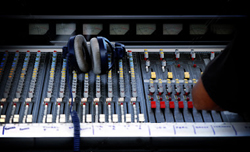
Delwyn came up assisting at Little Mountain Sound and has a page full of credits to his name. We met when I was the recording engineer on a session at Imperative Studios and he was coming in to mix the songs. I showed him the system and we brought up the first song.
The first thing that happened was not expected. Delwyn yelled at me. He hurt my feelings. What an unappreciative jerk! So what if I ignorantly made the job of mixing more difficult for him because of my poor preamp gain setting technique!
At Little Mountain, junior engineers were given the night recording gigs (usually for the local bar bands wanting the Little Mountain name for half price). There was one huge stipulation placed on them: they could use nothing other than the gain knob and console EQ and they absolutely could not use any outboard gear.
When the senior engineer arrived in the morning, all of the console faders had to be at unity. and when he pressed play on the multitrack, there had to be a solid mix already happening. Not a perfect mix, but one where all the elements were in their appropriate places. If the junior engineer couldn’t learn to get this right, he didn’t continue to work there.
When Delwyn explained this to me, it was like fireworks going off. Wow! This was the answer I had been seeking, and the problem all along was that I did not know how to ask the question!
Finally, I could see and understand a much better way to set gain. My brain did a major paradigm shift, and fortunately, Delwyn eventually forgave me.
The proper way for setting the channel gain on the console is not focusing on each channel itself, but rather, listening to where that channel fits in the mix.
Ever seen the house console photos in Live Sound magazine taken before the soundcheck, where you can see all of the console faders parked at unity? Now I know what these guys know. Dialing in a mix is so much easier when you’ve properly gain matched at the front-end, and it sounds best too.
This is not to say that you mix the whole show from the gain knobs – once they’re in the right position, mixing is properly done at the faders. A side benefit is that those mixing monitors from the main console aux will find it easier to get a quality monitor mix.
So if your mixes look more like Picture A than Picture B, it might be time to re-think your gain structure approach. Put yourself through the exercise of “What if I can’t move the faders from unity?” I think you’ll like the results.
Author’s Note: My thanks to Ted Brown and the Martin Woldson Theater at the Fox.
